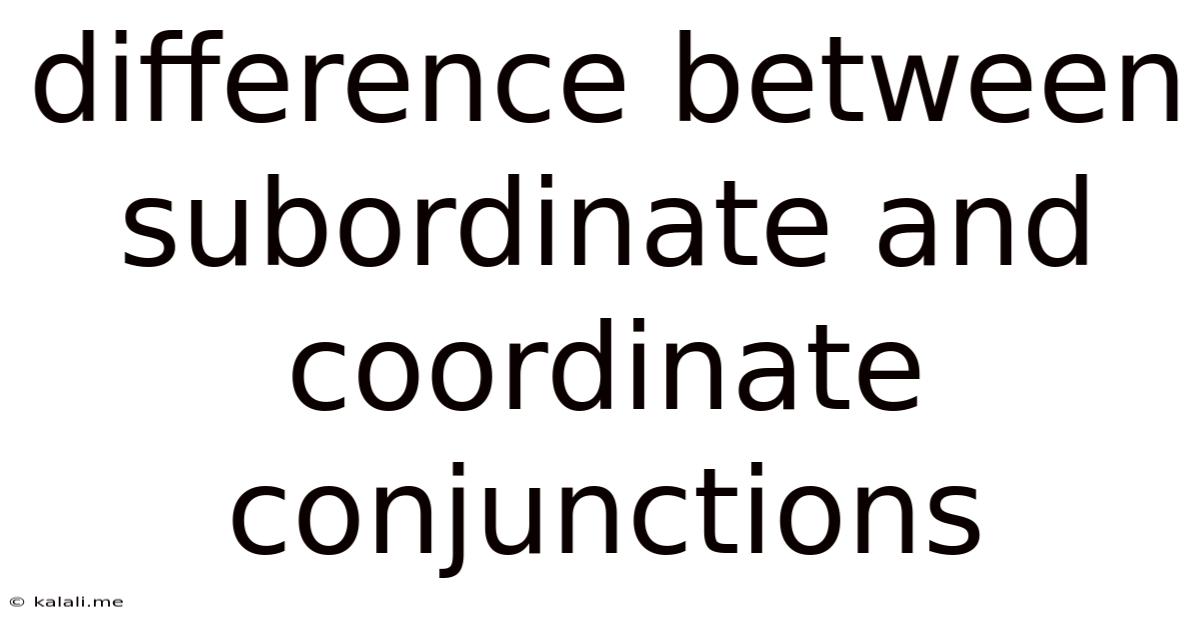Difference Between Subordinate And Coordinate Conjunctions
Kalali
Jun 11, 2025 · 3 min read

Table of Contents
The Great Divide: Understanding Subordinate vs. Coordinate Conjunctions
Understanding the difference between subordinate and coordinate conjunctions is crucial for crafting clear, grammatically correct, and impactful sentences. These tiny words play a massive role in how we connect ideas, and mastering their use significantly improves writing quality. This article will delve into the core distinctions, providing examples to solidify your understanding.
What are Conjunctions?
Before diving into the specifics, let's establish a baseline. Conjunctions are words that join words, phrases, or clauses. They act as the glue that holds sentences together, creating complex and nuanced expressions of thought. There are two main categories: subordinate and coordinate conjunctions.
Subordinate Conjunctions: The Supporting Players
Subordinate conjunctions introduce dependent clauses. A dependent clause, unlike an independent clause, cannot stand alone as a complete sentence; it relies on an independent clause for its meaning. Think of them as supporting players, adding context and detail to the main idea.
Key Characteristics:
- Create dependent clauses: They begin clauses that cannot stand alone.
- Show relationships: They indicate the relationship between the dependent and independent clauses (e.g., cause and effect, time, contrast).
- Examples: after, although, as, because, before, even if, if, in order that, once, since, so that, than, that, though, unless, until, when, whenever, where, whereas, while.
Examples in Sentences:
- Because it was raining, the picnic was canceled. (Because introduces a reason.)
- I will go to the party if you come too. (If introduces a condition.)
- Although she was tired, she finished the race. (Although introduces a contrast.)
- He studied hard so that he could pass the exam. (So that introduces a purpose.)
Coordinate Conjunctions: The Equal Partners
Coordinate conjunctions, in contrast, join independent clauses of equal grammatical rank. Each clause could stand alone as a complete sentence. They create a sense of balance and parallel structure in your writing. Remember the acronym FANBOYS to help you remember the seven coordinating conjunctions:
- For
- And
- Nor
- But
- Or
- Yet
- So
Key Characteristics:
- Join independent clauses: They connect clauses that can stand alone as sentences.
- Show relationships: They indicate the relationship between the clauses (e.g., addition, contrast, consequence).
- Use with commas: When joining two independent clauses, use a comma before the coordinating conjunction.
Examples in Sentences:
- The sun was shining, and the birds were singing. (Addition)
- I wanted to go to the beach, but it was raining. (Contrast)
- He studied hard, so he passed the exam. (Consequence)
- She didn't like the movie, nor did she like the snacks. (Addition of a negative idea)
Identifying the Conjunction: A Practical Guide
The most effective way to distinguish between subordinate and coordinate conjunctions is to analyze the clauses they connect. Ask yourself:
- Can each clause stand alone as a complete sentence? If yes, it's likely a coordinate conjunction. If no, it's likely a subordinate conjunction.
- What is the relationship between the clauses? This helps determine the type of conjunction used to show the relationship appropriately.
By understanding the differences between subordinate and coordinate conjunctions, you can craft more sophisticated and grammatically sound sentences, significantly enhancing the clarity and impact of your writing. Practice identifying these conjunctions in your reading and writing, and you'll quickly master this fundamental grammatical concept.
Latest Posts
Latest Posts
-
How Many 9s Are In A Deck Of Cards
Jul 01, 2025
-
How Many Pounds Are In 2 5 Kg
Jul 01, 2025
-
Which Is Greater 2 3 Or 2 4
Jul 01, 2025
-
How Do You Pass Level 7 On Bloxorz
Jul 01, 2025
-
If Your 13 What Year Were You Born
Jul 01, 2025
Related Post
Thank you for visiting our website which covers about Difference Between Subordinate And Coordinate Conjunctions . We hope the information provided has been useful to you. Feel free to contact us if you have any questions or need further assistance. See you next time and don't miss to bookmark.